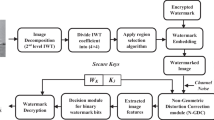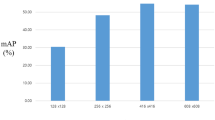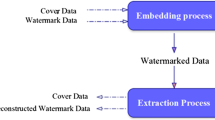Abstract
The H.266/Versatile Video Coding (VVC) standard, released in July 2020, has improved the encoder performance over the previous High Efficiency Video Coding (HEVC) with a significant increase in coding complexity. Enhancements on the transform module mainly involve the introduction of the Adaptive Multiple Transform (AMT) which has led to an additional computational complexity. This paper aims at reducing the transform module complexity by approximating the AMT core. The transform approximation has to reach a low MSE, a low total error energy, a low transform distortion and a high transform efficiency. The Particle Swarm Optimization (PSO) is used to solve the optimization problem modeled as a constrained one. The proposed approximate transforms preserve a good coding efficiency compared to the exact transforms and require a less arithmetic complexity as well. The hardware architectures of both the exact and the approximate versions of the 8, and 16-point DST VII transform are designed. The exact transforms are defined using multipliers and MCM-based designs. The approximate transforms are described using additions and bit-shifting operations. All the designs are implemented in the Arria 10 FPGA device. Synthesis results have shown that the proposed approximation saves more than 75% and 63% of logic utilization when compared to multipliers and MCM-based designs, respectively. The maximum operational frequency is of 180 MHz, supporting 2K and 4K videos at 231 and 58 fps, respectively.






Similar content being viewed by others
References
Ashraf, S., Saleem, S., Ahmed, T., Aslam, Z., Muhammad, D.: Conversion of adverse data corpus to shrewd output using sampling metrics. Vis. Comput. Indust. Biomed. Art 3(1), 1–13 (2020a)
Ashraf, S., Muhammad, D., Shuaeeb, M., Aslam, Z.: Development of shrewd cosmetology model through fuzzy logic. J. Res. Eng. Appl. Sci. 5(3), 93–99 (2020b)
Ashraf, S., Aslam, Z., Yahya, A., Tahir, A.: Underwater routing protocols: Analysis of intrepid link selection mechanism, challenges and strategies. Int. J. Sci. Res. Comput. Sci. Eng. 8:1–9 (2020c). https://www.isroset.org/journal/IJSRCSE/full_paper_view.php?paper_id=1808
Ashraf, S., Gao, M., Chen, Z., Naeem, H., Ahmad, A., Ahmed, T.: Underwater pragmatic routing approach through packet reverberation mechanism. IEEE Access 8, 163,091–163,114 (2020d)
Ashraf, S.: Towards shrewd object visualization mechanism. Trends Comput. Sci. Inf. Technol. 5(1), 097–102 (2020)
Bross, B.: Versatile Video Coding. (2020) https://www.digitalmedia.fraunhofer.de/content/dam/dcinema/en/documents/ ibc2020/2020_Flyer_Versatile%20Video%20Coding_final.pdf, online; accessed January 2021
Chen, J., Alshina, E., Sullivan, G.J., Ohm, J., Boyce, J.: Algorithm description of joint exploration test model 7 (jem 7). Joint Video Exploration Team (JVET) of ITU-T SG 16 (2017)
Rosewarne, C., Bross, B., Naccari, M., Sharman, K., Sullivan, G.: High efficiency video coding (hevc) test model 16 (hm 16) improved encoder description update 6. Joint Collaborative Team on Video Coding (JCT-VC) of ITU-T SG16 WP3 and ISO/IEC JTC1/SC29/WG11 24th Meeting: Geneva, Tech Rep (2016)
Chen, J., Karczewicz, M., Huang, Y.W., Choi, K., Ohm, J.R., Sullivan, G.J.: The joint exploration model (jem) for video compression with capability beyond hevc. IEEE Trans. Circ. Syst. Video Technol. (2019)
Mohammadi, A.A., Alizadeh, M.S., Sharifkhani, M.: Jvet encoder complexity analysis. In: 2018 IEEE International Symposium on Circuits and Systems (ISCAS), pp 1–5, (2018). https://doi.org/10.1109/ISCAS.2018.8351442
Cintra, R.J., Bayer, F.M.: A dct approximation for image compression. IEEE Signal Process. Lett. 18(10), 579–582 (2011)
Jridi, M., Alfalou, A., Meher, P.K.: A generalized algorithm and reconfigurable architecture for efficient and scalable orthogonal approximation of dct. IEEE Trans. Circ. Syst. I Regul. Pap. 62(2), 449–457 (2014)
Potluri, U.S., Madanayake, A., Cintra, R.J., Bayer, F.M., Kulasekera, S., Edirisuriya, A.: Improved 8-point approximate dct for image and video compression requiring only 14 additions. IEEE Trans. Circ. Syst. I Regul. Pap. 61(6), 1727–1740 (2014)
Renda, G., Masera, M., Martina, M., Masera, G.: Approximate arai dct architecture for hevc. In: 2017 New Generation of CAS (NGCAS), IEEE, pp 133–136 (2017)
Arai, Y., Agui, T., Nakajima, M.: A fast dct-sq scheme for images. IEICE Trans. (1976–1990) 71(11), 1095–1097 (1988)
Tablada, C., Bayer, F.M., Cintra, R.J.: A class of dct approximations based on the feig-winograd algorithm. Signal Process. 113, 38–51 (2015)
da Silveira, T.L., Bayer, F.M., Cintra, R.J., Kulasekera, S., Madanayake, A., Kozakevicius, A.J.: An orthogonal 16-point approximate dct for image and video compression. Multidimens. Syst. Signal Process. 27(1), 87–104 (2016)
da Silveira, T.L., Oliveira, R.S., Bayer, F.M., Cintra, R.J., Madanayake, A.: Multiplierless 16-point dct approximation for low-complexity image and video coding. SIViP 11(2), 227–233 (2017)
Jridi, M., Meher, P.K.: Scalable approximate dct architectures for efficient hevc-compliant video coding. IEEE Trans. Circ. Syst. Video Technol. 27(8), 1815–1825 (2017)
Jridi, M., Alfalou, A., Meher, P.K.: Efficient approximate core transform and its reconfigurable architectures for hevc. J. Real-Time Image Process. pp 1–11 (2018)
Oliveira, R.S., Cintra, R.J., Bayer, F.M., da Silveira, T.L., Madanayake, A., Leite, A.: Low-complexity 8-point dct approximation based on angle similarity for image and video coding. Multidimens. Syst. Signal Process. pp 1–32 (2018)
Chatterjee, S., Sarawadekar, K.: Approximated core transform architectures for hevc using wht-based decomposition method. IEEE Trans. Circ. Syst. I Regul. Pap. 66(11), 4296–4308 (2019)
Canterle, D.R., da Silveira, T.L., Bayer, F.M., Cintra, R.J.: A multiparametric class of low-complexity transforms for image and video coding. Signal Process. p 107685 (2020)
Chivukula, R.K., Reznik, Y.A.: Fast computing of discrete cosine and sine transforms of types vi and vii. In: Applications of Digital Image Processing XXXIV, International Society for Optics and Photonics, vol. 8135, p. 813505 (2011)
Zhang, Z., Zhao, X., Li, X., Li, L., Luo, Y., Liu, S., Li, Z.: Fast dst-7/dct-8 with dual implementation support for versatile video coding. IEEE Trans. Circ. Syst. Video Technol. (2020)
Cintra, R.J., Bayer, F.M., Madanayake, A., Potluri, U.S., Edirisuriya, A.: Fast algorithms and architectures for 8-point dst-ii/dst-vii approximations. J. Circ. Syst. Comput. 26(03), 1750,045 (2017)
Hamidouche, W., Philippe, P., Mohamed, C., Kammoun, A., Menard, D., Déforges, O.: Hardware-friendly dst-vii/dct-viii approximations for the versatile video coding standard. In: 2019 Picture Coding Symposium (PCS), pp 1–5, (2019). https://doi.org/10.1109/PCS48520.2019.8954535
Kammoun, A., Hamidouche, W., Philippe, P., Déforges, O., Belghith, F., Masmoudi, N., Nezan, J.F.: Forward-inverse 2d hardware implementation of approximate transform core for the vvc standard. IEEE Trans. Circ. Syst. Video Technol. (2019)
Ben Jdidia, S., Belghith, F., Jridi, M., Masmoudi, N.: A multicriteria optimization of the discrete sine transform for versatile video coding standard. Signal Image Video Process. pp 1–9 (2021)
Zeng, Y., Sun, H., Katto, J., Fan, Y.: Approximated reconfigurable transform architecture for vvc. In: 2021 IEEE Int. Sympos. Circ. Syst. (ISCAS), IEEE, pp 1–5 (2021)
Shi, Y.: Particle swarm optimization. IEEE Connect. 2(1), 8–13 (2004)
Parsopoulos, K.E., Vrahatis, M.N., et al.: Particle swarm optimization method for constrained optimization problems. Intell. Technol. Theory Appl. New Trends Intell. Technol. 76(1), 214–220 (2002)
Kennedy, J., Eberhart, R.: Particle swarm optimization. In: Proceedings of ICNN’95-International Conference on Neural Networks, IEEE, vol. 4, pp 1942–1948 (1995)
Jayalakshmi, M., Rao, S.N.: Discrete wavelet transmission and modified pso with aco based feed forward neural network model for brain tumour detection. CMC 65(2), 1081–1096 (2020)
Flury, B.N., Gautschi, W.: An algorithm for simultaneous orthogonal transformation of several positive definite symmetric matrices to nearly diagonal form. SIAM J. Sci. Stat. Comput. 7(1), 169–184 (1986). https://doi.org/10.1137/0907013
Oliveira, P.A., Cintra, R.J., Bayer, F.M., Kulasekera, S., Madanayake, A.: Low-complexity image and video coding based on an approximate discrete tchebichef transform. IEEE Trans. Circ. Syst. Video Technol. 27(5), 1066–1076 (2016)
Haweel, T.I.: A new square wave transform based on the dct. Signal Process. 81(11), 2309–2319 (2001)
Joint-Video-Exploration-Team (2019) JEVT Software Repository. https://jvet.hhi.fraunhofer.de/svn/svn_HMJEMSoftware/branches/HM-16.6-JEM-7.1-dev/, online; accessed March 2019
Bossen, F., Boyce, J., Suehring, K., Li, X., Seregin, V.: Jvet common test conditions and software reference configurations. JVET-K1010-v1 (2018)
Bjontegaard, G.: Calculation of average psnr differences between rd-curves (2001)
Mert, A.C., Kalali, E., Hamzaoglu, I.: High performance 2d transform hardware for future video coding. IEEE Trans. Consum. Electron. 63(2), 117–125 (2017)
Author information
Authors and Affiliations
Corresponding author
Additional information
Publisher's Note
Springer Nature remains neutral with regard to jurisdictional claims in published maps and institutional affiliations.
Rights and permissions
About this article
Cite this article
Ben Jdidia, S., Belghith, F., Sallem, A. et al. Hardware implementation of PSO-based approximate DST transform for VVC standard. J Real-Time Image Proc 19, 87–101 (2022). https://doi.org/10.1007/s11554-021-01160-5
Received:
Accepted:
Published:
Issue Date:
DOI: https://doi.org/10.1007/s11554-021-01160-5




